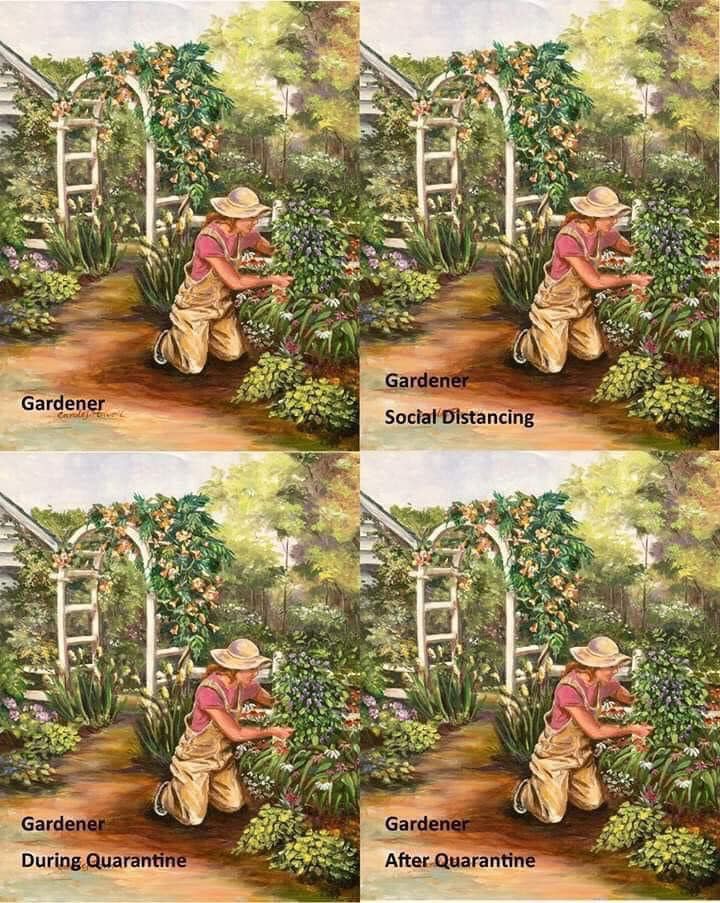Whatever the outcome of this current deadly disruption, corona virus has certainly focused many minds on the meaning of life–and on getting stuff done. Without the opportunity to procrastinate, tasks and projects in the Clarke household are being completed in record time; like clearing up the greenhouse, sorting the seed from the dust, the compost from the mulch, repotting conservatory plants whose toes are being pinched. I’ve never been so busy! And since snow fell again last week in Colorado and New Mexico, these indoor garden tasks tone up us southwesterners for the season ahead.

But in many ways, life is not all that different for some, who like me, prefer the solitary diligence of digging in the soil to the life of a social butterfly. The meme, above, has been going the rounds on Facebook lately, and I and friends all over the globe have certainly identified with it. We all cherish our “space” – our gardens and garden rooms – and the form each takes is a highly personal expression of what makes us happy and content, and gives us the space to think. For Henry David Thoreau, it was a tiny cabin near Walden Pond. Its dark interior illuminated by only one small window, is it any wonder he spent so much time “in nature”, declaring that his favorite room was the piney woods surrounding him. As winter receded he’d turf his desk and few furnishings into the sunshine, bringing the indoors out and obliterating boundaries. From there, it’s a short stroll to the Bauhaus architects, who reasoned that by removing the sense of enclosure, and putting humanity in a more intimate contact with nature, glass walls would free the collective creative spirit and elevate culture to another, better plane. Modernists had such lofty thoughts. Of course, nature could only be experienced if the windows could be opened, and few enormous plate glass windows can be, so we get back to the idea of putting our furniture outside, and so domesticating nature.

Mediterranean culture had this down to fine art, and a Spanish or Mexican patio is a fine place to be on balmy day. The refreshing music of a bubbling, splashing fountain, walls and arcades clothed in scented climbers, shade from fruit trees, pops of bright color from potted plants, entice and comfort the mind. Traditionally, all the rooms of a hacienda opened onto the patio creating an enclosure where family life was carried on in close contact with a private, interior, landscape.

In 1951, the first issue of the first modern magazine dedicated to landscape study and understanding was published by J. B. Jackson. Titled Landscape: Human Geography of the Southwest (which subtitle was later dropped to be more inclusive), Jackson set out to raise awareness that, “each [person] had his or her own landscape which was part of the way they related to the wider world.” That, far from being thought of as something to view and admire, landscape was in reality “a place with which we have daily contact… . It is where we live and work and celebrate together.” He wanted people to understand that, for example, a line of telephone poles was as important a landscape artifact as a stand of quaking aspen. Jackson put cultural geography on the curriculum, and was the first to show us how to read the landscape, and to reconsider how we respond to it, viewing it not as a picturesque scene or as an outsider looking on, but as an active participant in our surroundings. At the moment, this is perhaps with a greater degree of understanding that just by being, we change the world we live in. And, as the pandemic is revealing all too clearly, it’s up to us to what degree we allow that change to happen.
©Ethne Clarke, 2020
To see more of Carole Powell’s work, visit https://pixels.com/profiles/carole-powell
To learn about J.B Jackson in greater detail, a biography written by Helen Lefkowitz Horowitz has recently been published by the University of Virginia Press. Link to the book’s page here: https://www.upress.virginia.edu/title/5339
See also Prof. Horowitz’s article ‘The Writer’s Path: J. B. Jackson and Cultural Geography as a Literary Genre”, SiteLINES: A Journal of Place, Vol. 11, No. 1 (Fall 2015), pp. 3-7, published by the Foundation for Landscape Studies. https://www.jstor.org/stable/10.2307/24889498


